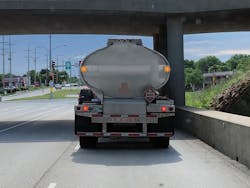It may come as no surprise that traffic accidents due to distracted driving have increased sharply in recent years. A large percentage of the U.S. population using smartphones and a still relatively small percentage of vehicles on the road today equipped with advanced driver assistance systems is a recipe for disaster. As drivers text a friend or scroll through social media, their attention is diverted from the task at hand—driving—and many of them will unintentionally collide with another vehicle or stationary object.
Vehicles are required to have working brake lights and turn signals to notify drivers behind them what they are doing and help mitigate these accidents, but many times these are not enough to command a smartphone user’s attention. Increasingly, heavy duty trucks are being rear-ended by distracted drivers.
A collision poses a danger to the lives of both parties, and it can be costly as well; not only in vehicle repair or replacement, but also in litigation should the driver of the rear vehicle blame the driver of the truck or the equipment involved (e.g. inadequate trailer lighting).
For these reasons, some in the industry seek to add an extra safety device to the rear of trucks and trailers in order to grab the attention of distracted drivers: brake-activated, pulsating lamps in addition to standard steady-burning brake lamps. While some of these lights consistently pulsate, others pulse before changing to a steady burn that matches the standard brake lights.
“These lights create a novel, strobe-like lighting state when they first come on, before settling on a solid on state,” said Marcus Hester, vice president of sales and marketing for Optronics International | USA Harness International. “By running this two-state sequence, pulsating brake lights are more likely to attract the attention of others on the road. Because they initially pulsate, they are different from the solid or relatively slowly blinking lighting patterns that are usually encountered and are more reminiscent of emergency vehicle lighting.”
Tanker fleet Groendyke Transport did a study with 500 of their trailers to test the effectiveness of this additional light.
“Groendyke Transport started installing flashing lights tied to their brake circuit,” said Mark Blackford, director of national fleet sales at Grote Industries. “They did that on 500-some trailers, then there was also a study group of 500 [trailers] that did not have them. They ran those for three years. The data indicated over three years that there was a 33.7% reduction in rear end collisions. During the same time, they had zero collisions at railroad crossings.”
Regulations and exemptions
The only problem with utilizing pulsating brake-activated lights was that the current Federal Motor Carrier Safety Administration (FMCSA) regulation, 49 CFR 393.25(e), requires all exterior lamps to be steady-burning. According to the regulation, “All exterior lamps (both required lamps and any additional lamps) shall be steady-burning with the exception of turn signal lamps; hazard warning signal lamps; school bus warning lamps; amber warning lamps or flashing warning lamps on tow trucks and commercial motor vehicles transporting oversized loads; and warning lamps on emergency and service vehicles authorized by State or local authorities.”
Groendyke Transport applied for an exemption to allow the use of an amber brake-activated pulsating lamp on its trailers in addition to the steady-burning brake lamps required by the Federal Motor Carrier Safety Regulations (FMCSR). In 2019, the FMCSA granted a five-year exemption.
In October 2020, National Tank Truck Carriers (NTTC) applied for and was granted a similar exemption for all U.S. tanker trailers, Grote’s Blackford said. Following this, Grote applied for and was granted yet a further exemption.
“Grote created and was granted a waiver, not only for all tanker trailers, but basically for all trailers: dry vans, reefers, and truck bodies,” Blackwood explained. “Basically, [this applies to] all equipment being pulled down the road, or trucks that are driving down the road.”
Grote developed a pulsating, brake-activated light that flashes amber five times in four seconds, then switches to a steady red burn to match the standard brake lights. If the driver releases the brake pedal and then re-applies the brakes, the pattern starts again with the five amber pulses followed by the steady red burn.
Now that the exemptions are in place and applicable to virtually all heavy-duty trucks and trailers on the road today, and the technology is developed and readily available, more fleets and other organizations can test pulsating brake lights to see what impact they have on fleet safety and equipment.
Installation
Since there are multiple exemptions, there is not yet one set standard for where these lights must be mounted on the back of the trailer or how many should be used.
“Groendyke used a single, amber light mounted centrally on their tanker trailers,” said Jeff Geoffroy, director of marketing and business development at Peterson Manufacturing. “This provides the minimum cost as you only have one lamp and harness extension. Another option some fleets have investigated is dual upper outboard [lights]. This requires two amber pulsating lights and two harnesses.”
These are typically mounted about halfway up the back of the tank.
Schneider National, a fleet based in Green Bay, Wisconsin, worked with Grote to add pulsating brake lights to their trailers.
“Their goal was to alert the driver within 40 yards,” Blackford said. “ It was their desire—and our desire—to put these at passenger car eye-level behind the trailer.”
On a reefer trailer, however, that would typically mean the lights have to be mounted on the doors, Blackford said. Doors either swing out or roll up, making installation complicated and more costly, so Grote settled on placing the lights between the existing trailer brake lights.
Wherever the new lights are mounted, installation methods will vary based on the trailer type.
“Adding a light to the back of a tanker is a challenge because you can’t drill into a tanker nor can you weld to the tank,” Geoffroy said. “Many fleets are using a bracket with double sided adhesive to hold the lamp in place.”
While large holes should not be cut into any type of trailer, small holes for rivets are typically acceptable as long as they are not on a tank, making a surface-mount application ideal.
“Because the fleet wants it to be retrofittable and cost-effective, surface mount was the goal,” Blackford said. “When you start cutting plasma holes into the structure of the back of the trailer, there's some integrity issues. Trailer manufacturers don't really recommend cutting holes in the frame. The surface mount with a couple of a 3/16" rivets is the mount [Grote uses].”
No matter the trailer type, wiring should be a relatively simple plug-and-play operation. Whether using one lamp or two, both types tie into the brake light harness for power and brake signal, Geoffroy said.
Blackford noted that Grote’s lights include adapters as well, which plug into the existing brake light harness, creating Ys in the wiring.
“One of the Y's goes to the existing taillight, and the others go to this light,” he said. “There's no cutting or splicing; it's plug and play.”
Blackford said that once the required tools are gathered, it should take a technician about 30 minutes for the first install. If they are adding two lights to a trailer, it would be “a total of maybe 40 minutes for the pair.”
For each light installed the technician will need to drill one 3/8” hole for the wire to pass through, Blackford noted, as well as the two 3/16” rivets.
Maintenance and inspection
Once the lights are installed, there is not much fleets need to do in terms of maintenance.
“The Grote motto for maintenance on a Grote UBS Harness LED Package is, ‘leave it alone,’” Blackford said. “We design things built to last 10 years or more unless you get into catastrophic issues with damages or repair. You don't need to do anything other than keep abrasive chemicals off of it.”
He explained that Grote and others in the industry recommend that fleets refrain from using high pH or high alkaline chemicals, because they can have a negative impact on polycarbonates and acrylics.
“It’ll make your metal shine, but it will dull your lenses,” said Kristin Bridges, marketing manager for Grote.
Peterson’s Geoffroy noted that checking trailer lights for proper operation requires a helper or a mirror positioned behind the trailer. He also offered the following recommended practices for inspecting pulsating brake lights and other trailer lights.
- Make sure the lenses are clean. They may be functional, but if they are dirty, they may appear to be malfunctioning to an inspector.
- Check electrical harnesses for any signs of wear or damage. Once moisture gets an entry point into a harness, it will use capillary action to wick its way throughout the entire system corroding wires, connectors, and LED lamp circuit boards.
- Ensure there are no signs of a cracked or damaged lens; this is a guaranteed entry point for moisture which will eventually corrode the inside of the light and cause it to fail.
- Try to have a co-worker watch the vehicle as it is driven around the parking lot; moving vehicles can have flickering lights that will never be seen when the truck and trailer are sitting still.
- Post-trip inspections are important. LED lights have circuit boards, and if they get damaged, they can overheat. Feel the lights at the end of a drive and see if there is any excessive heat—that is a warning sign that cannot be found at the start of a shift.
Manual inspection aside, trucks today are increasingly spec’d with automated light checking capabilities, Optronics’s Hester noted.
“Many modern cabs have a lighting test switch built into the vehicle instrument cluster,” he explained. “Once the switch is turned on, the vehicle will start cycling through the different brake, turn, hazard lighting sequences, and will keep doing so until the switch is turned back off again. This will make it easy to verify that the pulsating brake lights are working properly.”
If a fleet’s vehicles do not have a light-out detection system built in, aftermarket versions are available, said Blackford. That would let the fleet know immediately if there are any failed lights.
The future of pulsating brake lights
Pulsating brake-activated trailer lights are a relatively new concept, so adoption rates are still low. Grote’s Blackford, however, expressed that the company expects to see a ramp-up of usage amongst heavy-duty fleets.
“I expect over the next five years for the popularity of this to become fairly commonplace, and I expect that these fleets are going to be able to have some very significant data points that they can review,” he said.
While regulatory groups can sometimes be at odds with fleets and manufacturers, Blackford pointed out that all parties are in agreement when it comes this concept.
“FMCSA was very, very supportive of this whole initiative,” he said. “They encouraged us to go down this path when we approached them.”
In addition to safety records and government support, Blackford said he expects pulsating brake-activated lights to become popular due to an unexpected side-effect: ROI.
“The return on investment on this turns out to be positive,” he said. “Fleets have calculated … if this light is on trailers that they're cycling out of service, i.e., selling off, they think there's going to be an additional residual value because this light is on there.”
While cost savings and decreased vehicle downtime are all positive outcomes, the most important factor when looking at utilizing pulsating brake-activated lights remains safety: preventing tragedies that may otherwise occur due to a careless traffic accident.
“I really believe in this product,” Blackford said. “I think it's going to save lives.”






